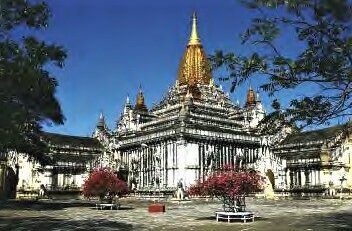Sacred Sites of Burma, Myth and Folklore in an Evolving Spiritual Realm
by Donald M. Stadtner
Khmer relics in Burma/Myanmar, and the history of Mon-Khmer culture in the country.

Publication: River Books, Bangkok | PHOTOGRAPHY PAISARN PIAMMATTAWAT AND DONALD M. STADTNER
Published: 2011
Author: Donald M. Stadtner
Pages: 177
Language : English
Khmer bronzes taken as booty from Angkor in the 15th century by Thais were then seized by Burmese invaders at Ayutthaya and taken to Pegu and then Toungoo. They were then removed to Rakhine, from where they were finally shifted in 1785 to the Mahamuni Temple.
Regarding the Mon and Mon-Khmer influence in Burma, the author remarks: "The traditional enmity between the Burmese and Mon kept in check during the colonial era was unleashed after independence when decades of warfare erupted (South). Mon autonomy is no longer a threat, and there is even a Mon state, with the hamsa featured on its flag. The military government has striven to put a national stamp on Mon turf by restoring Buddhist sites in Mon areas."
For historical background, the Pegu region was inhabited by Mon in the first millennium, but came under Pagan’s influence by the 11th century. According to the author, 'the Mon reasserted themselves in Lower Burma by the late 13th century and established Pegu as a capital during the reign of Banya U (r. 1369-1384). The oldest parts of the city are thought to be east of Hintha Gon hill but only brick ruins survive. Pegu flourished during the reign of the great Mon king named Dhammaceti (r.1470-1492). Dhammaceti’s grandson fell to Burmese forces from Toungoo when Pegu was seized in 1538, thus beginning the inexorable decline of Mon fortunes in Lower Burma. By the late 18th century the delta was comprised of sixty per cent Mon and forty per cent Burmese. The Mon enjoyed a resurgence in Pegu in the 18th century but lost the town to forces from Upper Burma in 1757. Pegu became the capital of Lower Burma in the 1850s following the Second Anglo-Burmese War, before it was shifted to Yangon in 1862.'
Photo: The Ananda Temple.
Tags: Burma, Ayuthya, decline and fall, Pegu, Myanmar, art history, Mon, Mon-Khmer
About the Author

Donald M. Stadtner
Donald M. Stadtner (b. 1947) was for many years an Associate Professor of Art History at the University of Texas, Austin, after receiving his Ph.D in Indian art at the University of California, Berkeley. He was first in Burma in 1979, followed by visits in the 1980's sponsored by the Smithsonian Institution. His numerous publications deal with both Indian and Burmese art, with his 2005 book Ancient Pagan focusing exclusively on Burma's ancient capital city.
In 2005, his expertise helped to abort the purchase of a stolen statue of a Seated Buddha from India by the Royal Ontario Museum.
Donald Stadtner divides his time between the San Francisco Bay area, India and Southeast Asia.
